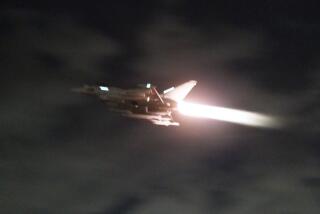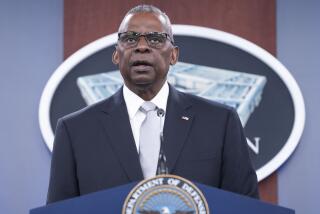Carlucci: The Libyan Jets ‘Sought to Put Their Nose on Our Aircraft’ Five Times
- Share via
\o7 WASHINGTON\f7 — Here is a partial transcript of the Pentagon briefing Wednesday by Defense Secretary Frank C. Carlucci and Adm. William J. Crowe Jr., chairman of the Joint Chiefs of Staff, on the incident in which two U.S. Navy planes shot down two Libyan jet fighters over the Mediterranean Sea.
Carlucci: Good morning. The chairman and I are here to present the facts of the Libyan incident, as we understand them at this point. And let me emphasize that. These are preliminary reports, and preliminary reports are never 100% accurate. There are always changes in detail. But in the interest of getting to the American public and the world in general the information that we have, we’re going to present a statement based on that information, but I urge you to take into account the fact that preliminary reports sometimes do change.
This morning at about 5 a.m. Eastern Standard Time, or 12 a.m. local time in the Mediterranean, two Libyan MIG-23 aircraft were shot down in self-defense by American F-14s with air-to-air missiles. Two parachutes were sighted, and a Libyan search-and-rescue helicopter was later detected headed for the area.
The U.S. Navy aircraft were operating from the aircraft carrier John F. Kennedy, which was off the southwest tip of Crete and about 127 miles north of Tobruk, Libya.
At the time of the incident, both the ship and its aircraft were conducting training operations in international waters. The two F-14s were providing combat air patrol approximately 50 miles south of the Kennedy, which is about 70 miles north of the northeast Libyan coast.
The MIG aircraft were detected shortly after they left Al Bumbah at about 4:50 a.m. Eastern Standard Time and were tracked as they closed (on) the two F-14 aircraft. The F-14 pilots maneuvered to avoid the closing aircraft. They changed speed, altitude and direction. The Libyan aircraft continued to close in a hostile manner. At about 14 miles, the U.S. section leader decided his aircraft was in jeopardy, and they could wait no longer. One MIG-23 was shot down with a Sparrow missile. The second MIG was shot down by a Sidewinder missile at 6 miles.
These 6th Fleet ships and aircraft were operating in international waters and international airspace at the time of the incident and posed no threat to Libya. These routine operations are of the same type that have been conducted in the same area many times in the past. The 6th Fleet operations have no connection whatsoever with Libya’s newly constructed chemical facility.
Q. What were the indications of hostile intent?
Carlucci: Bear in mind what I said earlier, that these are preliminary reports. The pilots are being flown to Naples for a detailed debrief. So, we will not know the actual maneuvers that took place until we have the detailed debrief from the pilots.
But, based on our current information--and I emphasize that point--the pilots descended in altitude from approximately 15,000 feet to 4,000 feet, and they took about five different evasive actions, and each time the Libyan aircraft sought to put their nose on our aircraft; they also accelerated. So, the hostile intent seems to be fairly clear.
Q. What were the rules of engagement?
Carlucci: Normal peacetime rules of engagement.
Q. Who gave the OK to fire?
Q. They didn’t have to go back to the Kennedy and ask for weapons release authority?
Carlucci: A lead pilot has the authority to make this judgment on his own.
Q. Did the lead pilot fire both missiles?
Crowe: It’s clear both aircraft fired. One was hit with a Sidewinder and one was hit with a Sparrow. We think they both came from the lead aircraft, but both aircraft did fire missiles.
Q. Libya has been bloodied in the past by confronting the U.S. with planes and ships. Why would they do this?
Carlucci: You’ll have to ask them, not us.
Q. Well, they had said they expected the U.S. to attack Libya because of this chemical weapons plant.
Carlucci: All I can do is emphasize that these were routine carrier maneuvers, a carrier battle group that has been in the Mediterranean steadily. We’ve had them there for years. It was on a normal training mission. It is en route to port. It will continue en route to port. This has nothing whatsoever to do with all the speculation that has existed.
Q. We in no way provoked them, or drew them into this?
Carlucci: Absolutely not.
Q. How long had the carrier actually been in the general vicinity, within 100 or 120 miles of Libya?
Crowe: Since the Christmas vacation.
Q. And had it been conducting flight operations on a continuing basis during that time?
Crowe: A few hours each day.
Q. Have the activities of the Libyans been normal? Have they been checking out U.S. aircraft a little more than routine lately?
Carlucci: We had not noticed any abnormal activities until this incident.
Q. Does that Libyan chemical plant pose any imminent threat to the region, and what, if any, threats to U.S. interests?
Carlucci: The State Department has indicated that we are gravely concerned with that chemical facility, and I don’t think it would be appropriate to go beyond that statement.
Q. Were the planes capable of making an attack on the so-called weapons--or chemical weapons plant?
Carlucci: If you were going to make an attack on the chemical plant, you would not position your carrier about 600 miles away.
Crowe: Nor used F-14 aircraft.
Q. Was there any indication that the planes were going to fire? That the MIGs were going to fire?
Carlucci: I’ve indicated that, by their maneuvers, they were clearly acting in a hostile fashion.
Q. Did they lock on with the radar?
Crowe: Once again, let me emphasize the point, we have some preliminary information that radars were turned on. We do not know the nature of the radars. We do not--until we debrief the pilots, it is really not appropriate to get into that kind of detail.
Q. Other than the MIGs that were shot down, were there any other Libyan forces in the area that you are aware of?
Carlucci: Not that we’re aware of.
Q. Could you describe any plane-to-plane conversations between the Americans and the Libyans or perhaps any other conversations.
Carlucci: That’s a little detail that we shouldn’t get into until we’ve had the debriefing of the pilots.
Q. Well, we understand they were warned. Can you tell us how they were warned?
Carlucci: No. I’m not aware of any warnings.
Q. In the previous week or 10 days, had there been any report from the area of suspicious or threatening behavior by the Libyans of any kind?
Carlucci: No. Not to my knowledge.
Q. The Navy is saying . . . that the planes were warned in English to break off. Are you saying that there was no such warning?
Carlucci: I know of no warning. Once again, we will debrief the pilots, but at this point, we know of no warnings.
Q. You said this had no connection to the chemical weapons plant. But didn’t that dispute over the chemical weapons plant create heightened tensions? And did that in some way contribute to what happened?
Carlucci: We have expressed our grave concern over the chemical weapons plant. There is a conference convening in Paris on Jan. 7 to deal with the worldwide issue of chemical weapons. We will, of course, at that conference express our concerns about the Libyan facility. But there is no way in which our military--routine military training--can contribute to heightened tensions in the area.
Q. Do you think this incident will have any impact on this whole dispute about the chemical weapons plant?
Carlucci: I indicated that we consider the incident closed.
More to Read
Sign up for Essential California
The most important California stories and recommendations in your inbox every morning.
You may occasionally receive promotional content from the Los Angeles Times.













